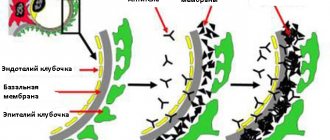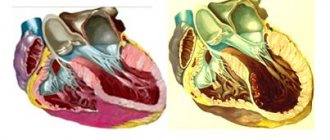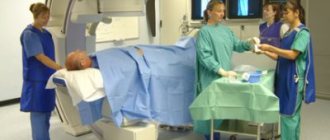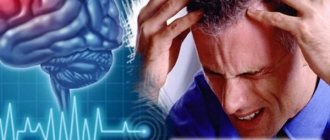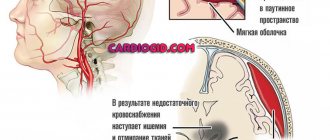What is thrombolysis
Signs of a stroke develop when there is pathological narrowing or blockage of the arteries supplying the brain. Violation of the patency of a vessel most often occurs due to the formation of a blood clot in its lumen, which forms when the coagulation system is activated.
In order to restore normal blood flow, agents are used for thrombolysis - dissolution and destruction of intravascular thrombus. At the moment, many thrombolytic drugs have been developed, differing in the mechanism of action of the active components, the rate of thrombus dissolution, and the features of application.
Thrombolytic therapy is used for various pathologies associated with increased thrombus formation: myocardial infarction, pulmonary embolism, intracardiac thrombi.
Thrombolysis Basics
The protein plasminogen, which is involved in the mechanism of natural dissolution of blood clots, constantly circulates in the bloodstream. In order to destroy a blood clot, which is the cause of pathological processes in the body, it is necessary to convert plasminogen into plasmin, its active form.
The active components of thrombolytics, by stimulating the formation of plasmin, activate the blood’s ability to destroy blood clots.
Active plasmin breaks down fibrin filaments, a protein that forms the framework of a blood clot, which fragments into small particles and is removed, freeing the lumen of the vessel. This mechanism is the basis for the successful use of thrombolysis in ischemic stroke accompanied by severe neurological symptoms.
The condition for the effectiveness of thrombolysis is the earliest possible introduction of appropriate medications into the body.
Carrying out this technique within 6 hours after the first signs of a stroke significantly reduces the risk of severe irreversible consequences associated with the development of extensive necrosis of brain tissue. Timely thrombolysis for stroke reduces the risk of death by 20-26%.
Causes and symptoms of cerebral thrombosis
Thrombosis is a condition in which a person's blood vessels are blocked by blood clots, which impairs blood circulation. Blood clots usually form in arteries and veins. Thrombosis of cerebral vessels is a blockage of large vessels through which blood is delivered to the organ and supplies it with oxygen. A blood clot in the head disrupts the blood supply to the brain. If a person does not begin to be treated in a timely manner, this condition threatens an ischemic stroke of the brain with all its consequences: paralysis, disability and even death.
Indications for thrombolysis in stroke
Thrombolytic drugs are prescribed only on the basis of a confirmed diagnosis of cerebral stroke, after determining the causes of the pathology and the localization of vessel obstruction.
Indications for thrombolytic therapy are:
- clinical manifestation of a significant neurological deficit against the background of impaired blood supply: speech impairment, intense headache, limited mobility of the limbs, decreased vision;
- age from 18 to 80 years;
- exclusion of cerebral hemorrhages;
- diagnostic confirmation of thromboembolism;
- time interval no more than 4.5 hours from the manifestation of the first signs of pathology.
Thrombolytic therapy is carried out only in a hospital setting, under the supervision of a resuscitator.
An exception may be cases where long-term transportation of a patient with signs of a stroke is necessary, when medications are administered in an ambulance under constant monitoring of pressure, saturation, and pulse.
Clinic depending on the location of thrombosis
| Symptoms | |
| Middle cerebral | Speech impairment, paralysis of the upper or lower limbs. Impaired sensitivity. Decreased vision. |
| Forebrain | Paralysis of an arm or leg on the right or left, paresis of the facial muscles. Possible mental changes |
| Posterior brain | Loss of visual fields, visual hallucinations |
| Vertebro-basilar | Signs of cranial nerve damage, dizziness, nystagmus |
If the thrombus is localized in the extracranial (extracranial) part of the carotid artery, then a “flickering” of symptoms is observed, that is, they can disappear on their own and appear with varying severity and frequency.
Diagnostics
After delivering a victim with a suspected stroke to a medical facility, his condition is immediately examined to identify and urgently eliminate the cause of the blood flow disorder. A neurologist evaluates the general condition and severity of neurological abnormalities.
Computed tomography is used to visualize damage to brain tissue. The value of this method for stroke is its minimal duration, the ability to detect lesions from the first minutes of the ischemic process, and the reliable diagnosis of possible hemorrhage in the brain.
A blood test with a coagulogram is also required.
Rehabilitation period
Recovery after a cardioembolic stroke takes a fairly long period. The effectiveness of rehabilitation measures depends on the perseverance of relatives and the positive attitude of the patient himself. It is necessary to begin recovery while the patient is in the hospital, as soon as important indicators of the body’s condition are normalized.
The ideal option for rehabilitation after a stroke is a trip to a sanatorium-resort treatment. Such institutions have everything necessary to return a person to a full life. Services in sanatoriums are provided by specialists, so the likelihood of an incorrect rehabilitation course is minimal.
Physiotherapy
Exercise therapy is the main method designed to restore a patient’s motor ability after a stroke. For each patient, a set of exercises is developed individually. The volume and nature of classes depends on the severity of motor dysfunction and the person’s health status.
The complex of therapeutic exercises includes exercises that help develop muscle strength, restore range of motion in the arms and legs, and teach balance and walking. When paralysis occurs, passive exercise is performed by a specialist. He makes various movements with the patient’s limbs to normalize blood circulation in them and develop joints.
As sensitivity is restored, the patient begins to perform gymnastics independently, starting with the simplest manipulations and ending with complex active movements.
Classes with a speech therapist
In most people, after a cerebral infarction caused by thrombosis of the cerebral arteries, speech function suffers. The reason for this may be paralysis of the muscle tissues of the face and speech organs or damage to the speech center located in the left hemisphere of the brain. Dysfunction is expressed in slurred pronunciation, its complete absence, as well as deterioration in the perception of the speech of surrounding people.
A speech therapist will help you get rid of such consequences of a stroke. He conducts special classes with patients to rehabilitate the speech apparatus. Relatives can also help a person develop speech. They need to talk to the patient as often as possible.
Memory recovery
After a stroke, the patient’s memory also often suffers. Because of this, it is difficult for him to remember some events from the past. It even happens that a person does not recognize his relatives. For memory rehabilitation, regular training is required.
Most often, memory is trained by memorizing simple children's rhymes, since they are remembered and pronounced more easily than adult works. At the first stages, the patient remembers one sentence, then the amount of information is gradually increased.
Psychological and social rehabilitation
Psychological rehabilitation is important for patients after a cerebral stroke. Many patients suffer from depression because they regularly feel pain and cannot perform usual activities or appear in society. Patients consider themselves a burden to their relatives; they are depressed by the fact that they constantly need help.
To avoid the development of depression in the patient, relatives need to maintain a favorable psychological atmosphere in the house, always encourage the person who has suffered a stroke, and not give him a reason to consider himself an extra burden.
ATTENTION!!!
It is strictly forbidden to isolate a stroke patient from household chores, citing his inability to work. This will only develop a feeling of inferiority in him. Therefore, it is worth entrusting the patient with something very easy so that he can feel needed by the family.
Features and types of thrombolytic therapy
Depending on the nature of clinical manifestations, individual anatomical features and the prevalence of the pathological process, the following types of thrombolytic therapy are distinguished:
- systemic, in which, by introducing appropriate drugs, the anticoagulant system of the entire circulatory system is affected;
- selective, when drugs for thrombolysis are delivered directly to the site of thrombosis;
- mechanical destruction of the blood clot;
- combined, in which several techniques can be combined.
During systemic thrombolytic therapy, part of the drug is administered intravenously as a bolus, and part is administered by drip over 50-60 minutes. The thrombolytic increases the content of plasminogen in the general bloodstream, which helps eliminate thromboembolism.
During the first day of therapy, heart rate, respiration, and blood pressure are measured every hour.
When using the method of selective thrombolytic therapy, the drug acts not at the level of the systemic blood flow, but directly in the blocked vessel.
To deliver the drug, an endovascular catheter is used, advanced to the site of thromboembolism under X-ray control (angiography). The drug is administered through it within 1-2 hours. This technique is used for occlusion (blockage) of proximal segments of arteries.
If there are contraindications to the use of thrombolytics or drug therapy is unsuccessful, mechanical thrombolysis is used. This is a surgical intervention during which the blood clot is removed from the vessel using specialized instruments and devices.
For the purpose of extraction (removal) of a blood clot, ultrasound, aspiration (suction), and vena cava filters can be used.
Contraindications
In some conditions, thrombolytic therapy can lead to serious complications. Drug thrombolysis is contraindicated in the following cases:
- high blood pressure;
- mild neurological disorders;
- hemorrhage in the brain;
- diabetes mellitus;
- neoplasms with a risk of bleeding;
- severe liver diseases (portal hypertension, cirrhosis, active hepatitis);
- early postpartum period, pregnancy;
- bleeding disorders, reduced platelet count.
Drugs used for the procedure
Since the beginning of the use of thrombolytics in medicine, various pharmacological methods of influencing thrombosis have been developed and introduced. The improvement of active components followed the path of reducing their negative impact on blood properties and reducing the risk of side effects.
Today, the group of drugs for thrombolysis includes 5 generations:
- 1st generation – natural catalysts for the dissolution of fibrin, metabolic products of microorganisms (streptokinase, urokinase);
- 2nd generation – plasmin activators, artificially created by genetic engineering methods (actelyse, prourokinase);
- 3rd generation - drugs with improved selectivity of action, ensuring delivery to the blood clot (metalise, reteplase);
- 4th generation – lysis activators obtained using a combination of chemical and biological synthesis (urokinase-plasminogen)
- 5th generation - includes a composition of several fibrin-selective thrombolytics in one drug.
Medicines of the latest generations have minimal side effects on the systemic blood flow, as they have high selectivity (directed action on fibrin). The risk of developing allergies or intolerance reactions is also reduced. Despite these positive characteristics, thrombolytics can only be prescribed by the attending physician after a comprehensive study and exclusion of contraindications.
How do blood clots form in the head?
- The most common process of their formation is atherothrombosis. It happens like this: as a result of a violation of lipid metabolism, cholesterol is deposited in the intima of the vessel - an atherosclerotic plaque is formed. At the initial stage, it does not manifest itself in any way. Gradually increasing, it narrows the lumen of the vessel, and blood turbulence is created in this place. At some point, the plaque may tear the artery wall (most often this happens with a sudden surge in pressure). Platelets rush to the site of the tear and a blood clot forms.
The resulting clot can block the blood flow at its location, or it can break off and clog another, smaller vessel.
- Infectious and inflammatory processes (sinusitis, otitis, meningitis, boils, etc.) can cause septic thrombosis of the venous sinuses.
- Thromboembolism in the vessels of the head from other places. This is exactly what people call “a blood clot that has come off.” Most often, it enters the brain from the left side of the heart (left ventricle - aorta - brachiocephalic trunk - carotid artery - cerebral arteries). At the same time, thrombus formation in the heart occurs during: myocardial infarction;
- valve damage (rheumatic defects, infective endocarditis);
- the presence of artificial valves;
- cardiac aneurysms;
- atrial fibrillation. This is the most common cause of thrombosis today: with arrhythmia, the heart contracts with varying frequency and strength, blood flow slows down, and a clot forms.
But a blood clot can also break off in the head itself - for example, from the common or internal carotid artery it enters smaller branches and clogs them.
Surgical treatment for thrombosis in the head
Many people are interested in the question: is it possible to remove a blood clot from the head surgically? Theoretically, such an operation (thrombectomy) can be performed. Using access from the femoral artery under MRI control, a catheter with a special balloon can be brought to the thrombus, which “sucks it in”. But practically such manipulation is almost never carried out in the acute period of brain thrombosis. An alternative is selective thrombolysis, that is, applying thrombolytics directly to the clot and dissolving it.
If we talk about the acute period of thrombosis, surgical intervention is often performed for clots in the venous sinuses: craniotomy, opening the sinus and removing thrombotic masses.
Basically, all surgical interventions are aimed at preventing thrombus formation: both primary and secondary. That is, they are not carried out in the acute period.
- Carotid endarterectomy. This is an operation to remove atherosclerotic plaque in the carotid artery. It is performed for persons with significant arterial stenosis who have suffered several transient ischemic attacks.
- Carotid artery stenting. A special device is brought to the site of stenosis, which expands the lumen of the vessel.
- Thrombectomy from the chambers of the heart.
- Replacement of damaged heart valves.
How to diagnose
First of all, based on the symptoms. Even a non-medic may suspect a stroke. If a person suddenly becomes ill, you need to ask him:
- Smile. A person with a stroke will have a crooked smile, only one corner of the mouth will rise, the other will remain down.
- Raise both arms up. With paresis, one of them will lag behind.
- Ask for your name, age, address, today's date and month. If he has a stroke, he will not be able to answer at all, or his speech will be blurred and incomprehensible.
This test is called FAST (Face Arm Speech Test) - face-hand-speech.
If at least one of the signs is present, you must call an ambulance, and clearly list the symptoms.

